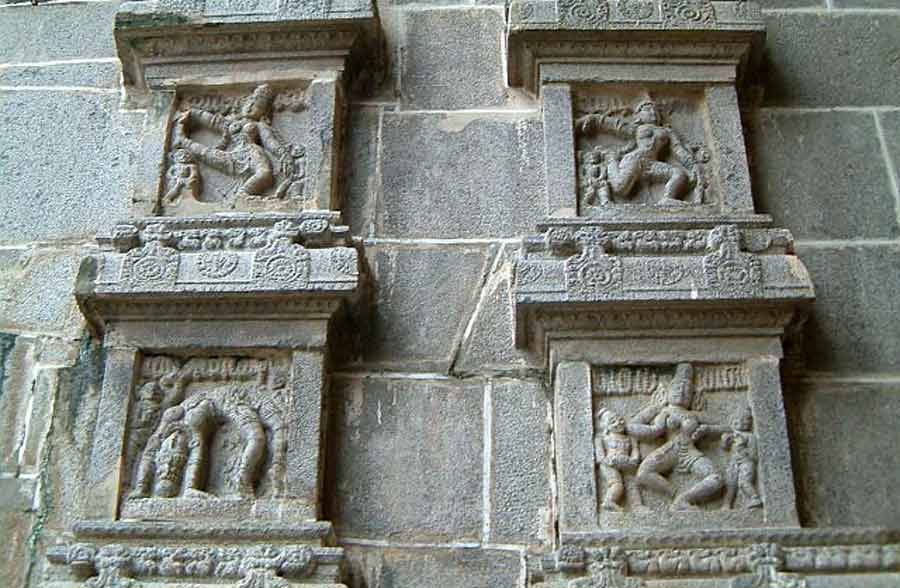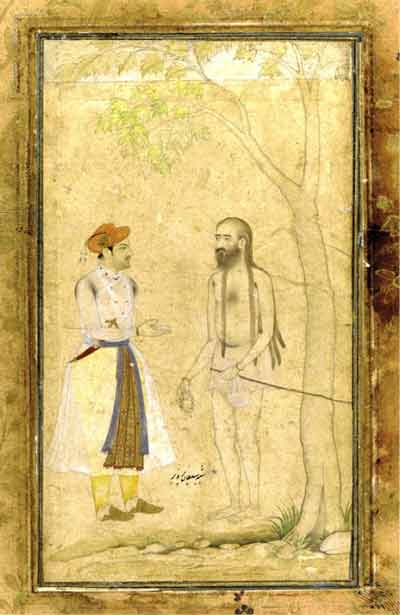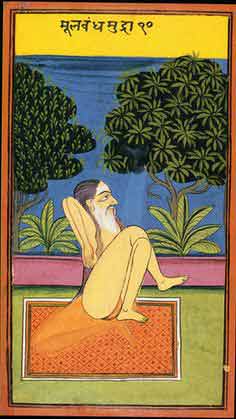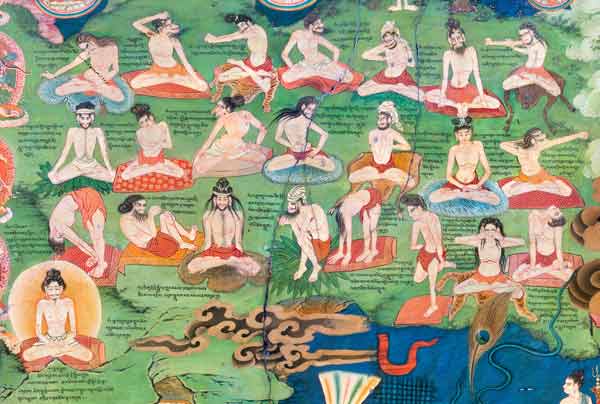
Chidambaram Temple Sculpture
Excerpts from YOGA MEDITATION - Through Mantra, Chakras and Kundalini to Spiritual Freedom. Published by Kaivalya Publications © Gregor Maehle 2013.
The Hatha Yoga or the Physical Dimension of Meditation
Hatha Yoga is the physical dimension of yoga, its two main disciplines being posture and breath work. But Hatha Yoga is not – or at least historically was
not – a style of yoga that reduced it to the physical aspect. In the beginning there was only the one yoga, sometimes referred to as Maha Yoga, the great
yoga. Before the one greater yoga broke apart into small factions, Hatha Yoga was the physical school through which all yogis had to pass. No yogi,
however, remained at the level of Hatha Yoga or even reduced yoga to this level. Hatha Yoga was thus the ‘primary school’ of the yogic education system. In
a similar fashion Raja Yoga was the meditation school of Maha Yoga, which all yogis attended during some part of their journey. We could liken it to
today’s high school level of education. In the ancient days you did not start this level of yoga without the primary education.
Similarly we can look at Bhakti Yoga, the devotional discipline of yoga, as the tertiary education level. It was attended after proficiency in Raja Yoga
had been gained: you would never go there straight from primary school or without any prior education. It is only in modern history that the link of these
disciplines has been fractured and people practise one or the other exclusively.
The medieval yoga text Hatha Ratnavali states that, without success in Hatha Yoga, Raja Yoga cannot be obtained.[1] This statement means that
spiritual realization has a physical dimension without which it is nothing more than self-hypnosis. Such self-hypnosis or belief can easily collapse in the
next crisis. Yogis are not satisfied with belief; they want to know. For, if you believe, how do you know that your belief is not wrong?
Deep knowledge, or vijnana as yogis call it, holds even in moments of crisis. Such knowledge has to hold even if it is tested in the difficult
moments of life. For this reason, to attain the total transformation of the human being it is not enough just to change your mind by sitting down and
meditating. This will not lead to lasting change. The body and the breath have to be included in the change as well. The higher yoga of meditation is a
seed that can sprout into the blossom of spiritual freedom, but for that to occur the seed has to be sown into ground that has undergone preparation
through Hatha Yoga.
While today on the one hand we face the problem of meditators
who do not adequately prepare the body for meditation,
on the other hand we have Hatha yogis
who get stuck in the meaningless drudgery of mere physical yoga.
If the yogi does not go beyond the practice of posture and breath work,
and does not
graduate to and include formal meditation,
then Hatha Yoga is not what it purports to be.
It is then mere body-building, body-beautifying and gymnastics.
There is nothing wrong with those,
as long as the label clearly states that we are doing only that.
The problem with today’s physical yoga is that it
pretends to be more.
And it is so only if it merges into the mental and spiritual disciplines of yoga.
The great Shankaracharya declares in his text Aparokhsanubhuti that Raja Yoga (i.e. the yoga of meditation) can lead to freedom, but only for
those whose minds are completely purified.[2] But he also says that, for those who have not reached that stage, Raja Yoga needs to be combined with Hatha
Yoga.[3] It is important that we do not prematurely nurture thoughts of attainment, as this will prevent true attainment. To counteract such tendencies, the Hatha Yoga Pradipika states that, as long as prana has not entered the Sushumna (central energy channel), all talk of knowledge is
nothing but the rambling of fools.[4] Yoga has always held that true knowledge is not something that just takes place in one’s mind, but that true knowledge
has a physical, a biochemical or bioelectrical, component (although one should never reduce it to that component alone). In yoga this component is called siddhi (power of attainment). Yogis believe that it is not enough just to talk about jnana (knowledge). Siddhi means that
attainment of true knowledge must also involve transformation of the body and breathing pattern. Otherwise knowledge is relegated to the sphere of belief
or just consists of bold statements.
Hatha Yoga is the discipline that deals with the physical and respiratory component of true knowledge. It is the foundation of all yoga, and it prepares
the yogi for the practice of the higher limbs.
Hatha Yoga also guarantees that we always remain firmly grounded and safe. The yogic idea of personality disorders such as schizophrenia and megalomania is
that certain higher energy centres (chakras) have been opened before some of the lower ones. This may result in a person accessing knowledge that
he/she cannot properly integrate. The result may be mental disorders. Hatha Yoga guarantees that the body and the breathing patterns are prepared to
conduct the large amounts of energy that spiritual insight brings. It makes sure that one does not get ahead of oneself in a very literal sense.

Sultan Parviz with an Ascetic, Mughal, c.1610, Freer-Sackler
The Raja Yoga or the Mental Dimension of Meditation
Today there is a great preoccupation with the physical side of yoga,
the Hatha Yoga. But the Hatha Yoga Pradipika states that to remain at
the level of Hatha Yoga and not graduate to Raja Yoga (yoga of meditation)
is nothing but a waste of energy.[5] Raja Yoga (royal yoga) is
the central part of yoga, its essence. In his commentary on Patanjali’s
Yoga Sutra,
the Rishi Vyasa said the immortal words ‘Yogah
samadhih’,[6] meaning yoga is the path of concentrating the mind.
What he wished to express was that central to yoga is the path of
concentrating the mind to such an extent that the world (and only
later the self) can be seen as it truly is.
To understand why concentration is necessary to achieve this we need to take recourse to the light-bulb-versus-laser metaphor. A conventional source of
light,
such as a light bulb, sends out light rays of different frequencies in
all directions. Even if light from such a source is focused into a beam,
the little packets of light that constitute it jostle each other so that it
spreads out and any shadows cast are not sharply defined.
A laser is different. In this case the packets of light are all of the
same frequency (‘coherent’), so the beam does not spread out and
shadows are precisely defined. For this reason a laser can be used to
transfer information accurately over long distances at a very high
speed; it can also be used to cut into objects that are not penetrable
by conventional sources of light.
The path of Raja Yoga deals with making the mind laser-like. It
concentrates thought waves to such an extent that information from
the object of meditation gets precisely transferred to the mind rather
than only a vague interpretation of it. Imagine how great it would
be to utilize such a mind?
Most problems in our lives are caused by errors of perception.
These may range from causing an accident by pulling into oncoming
traffic because we underestimated the speed of another car, to complex
cases were we wrongly judged another person because we projected
onto them our needs, fears or desires rather than saw them for who
they really are. Similarly, the mind can be transformed through Raja
Yoga so that it has the laser-like capacity to penetrate objects and
see or download their deep reality or essential blueprint. These
methods are used during objective samadhi, and Patanjali and other
sages used them to contribute to sciences such as psychology (yoga),
medicine (Ayurveda) and science of sound (Sanskrit).
This is a simplified exposition of Raja Yoga, a significant part of
which consists of practising objective samadhi on objects outside us
with the intention of gaining scientific knowledge to further human
society. This aspect of Raja Yoga has been only lightly touched on
here. Raja Yoga in itself is not the end of one’s development, for it
has to merge into Bhakti Yoga, the yoga of devotion to the Divine.
Without Hatha Yoga, Raja Yoga is empty of empowerment and,
without Bhakti Yoga, Raja Yoga is empty of heart.

Image from a manual of Haya Yoga
postures from the Punjab, cca 1830.
The Bhakti Yoga or the Spiritual Dimension of Meditation
While Hatha Yoga constitutes preparation for Raja Yoga, Bhakti
Yoga is the fruit of both. According to the Hatha Tatva Kaumudi,
Hatha Yoga is useless if the ecstasy of Bhakti is not attained.[7]
Bhakti Yoga, the yoga of devotion to the Divine, is the culmination
of yoga (although some say it has to merge into Jnana
Yoga).
It is important for the Bhakti yogi to prepare through the Hatha and
Raja Yogas. Although it is important that your yoga has a devotional
component right from the beginning, if one makes Bhakti one’s
main practice right from the outset, the problem is that one may end
up becoming a believer. If you believe in a particular form of the
Divine what will you do if you meet others who believe in another
form? You either doubt and become converted or you have a strong
belief and, in order to prove it, try to convert others, which often
leads to conflict.
True Bhakti leads you to an experience or view (darshana) of the
Divine. When you then meet others who have other beliefs you will
never be threatened. Instead of that there arises in you the wish to
support them and lead them to an experience of the Divine, not
according to your beliefs but according to theirs. And this is exactly
what the difference is between a religious believer and a bhakta (a
practitioner of Bhakti Yoga). A true bhakta knows that there is only
one Divine. This one Divine has spawned all sacred traditions and
therefore can be reached effectively through every single sacred
tradition. The question is not which tradition is right or wrong, for
there is none. The question is, how can the Divine be reached
quickly? The fastest way of enabling somebody to have a mystical
experience is to create it within their tradition, within their context
and not by destroying their beliefs beforehand.
For Bhakti Yoga to be truly effective
it has to grow out of Hatha Yoga and Raja Yoga.
Hatha Yoga is the motor of all yoga,
whereas Raja Yoga is its intelligence.
Both together make a formidable combination and
can enable one to attain the mystical aspects of yoga.
But unless they
are yoked by the heart of Bhakti Yoga,
one still follows one’s own
agenda.
With Bhakti Yoga one becomes able to serve the Divine
and
humanity and fulfil one’s own destiny.
Due to having been charred by religion, modern students often
baulk at the devotional aspect of yoga. They cannot relate to a Divine
outside of themselves. That is no problem. In this case just look at
Lord Krishna, Jesus Christ or the Buddha as being a representation
of the noblest within you, as a representation of your inner sacred
being and of your highest aspirations. If you begin in this way you will
gravitate towards the sacred within you and may get a confirmation
of the Divine outside of you later on.

Tibet's Secret Temple: The Long-Hidden Tantric Murals of Lukhang Palace
What Determines the Speed of your Spiritual Evolution?
The velocity of your spiritual evolution is determined by several factors,
foremost amongst which are:
• your karmic load
• the sophistication of your practice
• the intensity of your practice
• the grace of the Divine.
Let’s look at those factors briefly:
Karmic load
Your karmic load is determined by the totality of your past thoughts,
emotions, communications and actions. There are three forms of
karma, of which Prarabdha karma is the one that has formed your
present body and situation. It is difficult to change this karma, as it
has come to fruition already. If you want to change it you need to
take extraordinary measures (such as very advanced pranayama
practice), and there needs to be a significant benefit for your environment
for such a practice to succeed. For most people, Prarabdha
karma is what we need to come to terms with and accept. Because
of Prarabdha karma some people will progress faster than others. If
powerful obstacles to your spiritual practice become apparent, they
are due to past actions. You need to accept the results of your past
actions and proceed with your spiritual practice undeterred.
Sanchita
karma, the second type, is the karma that you have produced
by your past actions but has not yet come to fruition. It has
not yet become active because the opportunity for its fruition has
not yet arisen. But do not doubt that just because it has not become
active your karmic storehouse (karmashaya) is brimming with karma
that is waiting to come into action. For, as Lord Krishna said, ‘You
and I are ancient beings and have lived many lives. The difference
between us is that I do remember my past embodiments, you do
not.’[8] This almost infinite number of past embodiments has given us
ample opportunity to collect karmas and, as Patanjali says, ‘In the
case of the average person these karmas are mixed, meaning they do
contain a significant amount of demerit.[9]
The only reliable way of dealing with Sanchita karma is to intercept
it before it comes to fruition. This is done by attaining spiritual
freedom before it fructifies. When attaining spiritual freedom, the
seeds of karma become scorched and cannot fructify anymore.
Note that this approach works with Sanchita karma but not with Prarabdha
karma. Fructification of Sanchita karma generally occurs during
or right before one obtains one’s next embodiment. This means that,
from the total amount of Sanchita karma in your storehouse, the part
that needs to be attended to most urgently, converts itself into
Prarabdha
karma to form your new embodiment. From that moment
onwards the Prarabdha karma will play itself out one way or another,
whether the remainder of Sanchita karma can still be intercepted. If
this is duly contemplated and truly understood, one uses this fact as
a strong motor to increase the intensity and sophistication of one’s
practice, as both factors will enable us to intercept Sanchita karma.
Kriyamana
karma, the final form of karma, is what you are creating
now that will bear fruit in the future. With your thoughts and actions
today you are creating who you will be tomorrow. Contemplating
Kriyamana
karma will make you understand that you are creating
now in this moment who you will be in the future. Whoever you
have been in the past, whatever your limitations have been, leave it
behind and boldly create through your spiritual practice the new
person you will be in the future. This future does not have to be
many years or even lifetimes in the future. It will start exactly in the
next moment from now. Now!
Summarizing, while there are certain aspects of karma that are
difficult to change, the overwhelming thrust of the teaching of karma
goes in the direction that we need to take responsibility for who we
are and, if our ship is drifting towards the shallows or rapids, then
it is our responsibility to change its course and not that of our parents,
teachers, governments, unions, churches or whoever else. As it
is inherently difficult to determine what exactly our karmic load is,
we need not be deterred by it and, despite its existence – or better,
precisely because of its existence – move forward with confidence
and enthusiasm.
Karma teaches us a three-pronged strategy:
1. Consciously choose today your thoughts, emotions and actions
to create who you want to be tomorrow.
2. Take responsibility for your actions performed in the past.
3. Work towards spiritual liberation in this life.
Sophistication of practice
Excellent karma in India is often called ‘the gift of the last birth’,
although it is not really a gift but something that has in all cases been
earned. But even if you have excellent karma and great vigour to
pursue your practice, little is gained if you do not proceed with the
right steps. Similarly, an engineer who assembles an engine made up
of various parts will not get much energy output unless he assembles
it in the right order. The Taittirya Upanishad and other yogic texts have
laid stress on the fact that the human being is made up of various
layers, all of which need to be addressed by different forms of practice
such as asana, kriya, pranayama, meditation, yoga philosophy, devotion.
If these practices are not combined and linked, progress will
be slow or not forthcoming at all. Sophistication of practice means
that you practise all major aspects of yoga and combine practices
that were designed to fit together such as yogic asana, yogic breath
work and yogic meditation practices. Each of these components
should be designed using similar yogic principles. The speed of your
success will increase if you combine yogic asana with meditation
techniques that follow laws.
Intensity of practice
The intensity of your practice is often determined by what motivates
you. Some people are motivated by what they are trying to get away
from. A good example of this motivation is the Tibetan yogi Milarepa.
Following the command of his mother to destroy her enemies,
he murdered 35 people with black magic. After he had
completed this act, the karmic consequences of his actions dawned
upon him. Driven by fear of the karmic results, he motivated himself
to such an extent that he practised for several decades almost
unceasingly. He attained not only liberation in one lifetime but became
one of the most influential spiritual teachers of his country
and continues to be a beacon of light even today.
On the other scale of motivation is the desire to attain what you
do want. The Rishi Yajnavalkya tells us in the Brhad Aranyaka Upanishad
that the ecstasy of realizing the infinite consciousness is one
trillion times greater than the ecstasy gained by combining the maximum
pleasure available through power, sex and money. Acharya
Gaudapada said that the ecstasy of attaining the infinite consciousness
was beyond being expressed in words. Yogis need to motivate
themselves by looking forward to these states. If you do not know
where you are going you will end up somewhere else. Ideally one
motivates oneself simultaneously by looking forward to the positive results of spiritual
practice and contemplating the negative results that can be
avoided through it. That way the greatest intensity of practice can be
achieved and then success will come swiftly, as Patanjali said.[10]
Grace of the Divine
The most important factor in attaining spiritual liberation is an act
of grace of the Divine. Patanjali, the author of the Yoga Sutra, explains,
Samadhi siddhi Ishvara pranidhanat
, meaning the power of
samadhi
is attained through devotion to the Divine.[11] How does one
attract the grace of the Divine? By intensely loving the Divine. Lord
Krishna says to Arjuna that nothing is more resistible to God than
the love of the devotee.[12] God cannot but show grace to the devotee
who loves selflessly. But for this it is necessary to love the Divine
without asking for anything – to love the Divine for what it is
and not for its powers to fulfil wishes such as the longing for spiritual
liberation or even worldly objects. When you fall in love you do
not want to spoil it by constantly asking the beloved for favours.
He/she may otherwise feel you are not interested in them but only
in their ability to grant you favours or boons.
How can one selflessly love the Divine without asking for anything?
It is possible after one has gained at least a glimpse of the Divine,
after one has experienced some form of divine revelation. After
seeing that God is boundless beauty, infinite love, creativity and
freedom, it is actually difficult to feel anything but pure selfless love
towards the Divine.